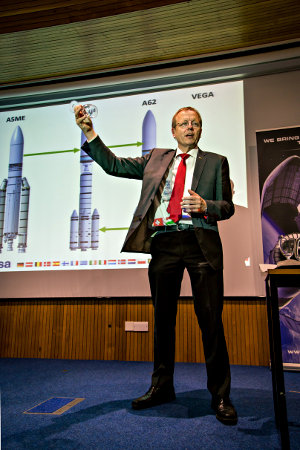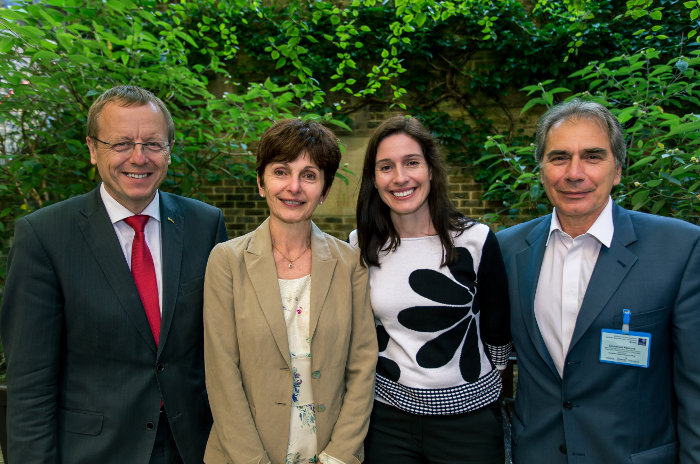First ESA satcom course a success
 Telecommunications make up the largest and most profitable part of the space industry. As a sector, it is also one that must evolve quickly to adapt to ever-changing user and technological demands.
Telecommunications make up the largest and most profitable part of the space industry. As a sector, it is also one that must evolve quickly to adapt to ever-changing user and technological demands.
In order for the sector to remain as flexible as possible, lots of different parts of the industry need to keep up in various ways: technologically, legally, and financially.
The urgent need to understand fluctuating market requirements is why ESA’s telecom directorate was inspired to work with Oxford University (UK) on a two-and-a-half-day course that provided a complete introductory overview to satcoms.
The course ran from 8 to 10 July in Oxford, and attracted many different kinds of professionals working in the satcom sector. A total of 42 professionals joined, with backgrounds ranging from engineering to legal and representing everything from space industry to operators, mobile operators and educational organisations.
Speakers included both ESA and industry market leaders, who contributed their own specific expertise and led practical sessions such as business case analysis.
The three days also included ample opportunity to network. A dinner on the second day allowed participants and speakers to exchange views and potentially identify future developments and areas for cooperation.
Showing their support for the course, Jan Woerner, ESA’s Director General, and Magali Vaissiere, Director of Telecommunications & Integrated Applications at ESA, joined the networking event. Woerner gave a talk about ESA’s plans for future programmes, while Vaissiere spoke about ESA’s Advanced Research in Telecommunications Systems programme (ARTES), and its role in supporting satcoms and the competitiveness of European industry.
The final programme was composed of three blocks: Introduction to satellite communications; Systems, services, markets and business; Satellite Architecture and Technologies; and a business case simulation, requiring participants to apply what they had learned.
The lectures and speakers were as follows:
|
Introduction to satellite communications |
|
|
An overview of satcoms markets |
Dr Emmanuel Rammos, Head of the Telecom Director’s Office, Senior Advisor, ESA |
|
Satcoms: a valuable infrastructure driven by the market requirements |
Dr Emmanuel Rammos, Head of the Telecom Director’s Office, Senior Advisor, ESA |
|
Satellite communications basics |
Dr Ana Bolea-Alamañac, System and Payload Manager SAT-AIS 2B Programme, ESA |
|
Systems, services, markets and business |
|
|
Satcoms broadcasting systems |
Cristiano Benzi, Director of Business Unit Video and Broadcasting, Head of PreSales, Head of Occasional Use, Eutelsat |
|
Satellite broadband systems |
Graham Peters, Director, Avanti Consulting |
|
Mobile satcom systems and services |
Ruy Pinto, Group Chief Operations Officer, Inmarsat plc |
|
Hybrid satellites – terrestrial systems |
Martin Halliwell, Chief Technology Officer, SES |
|
Satellite Architecture and Technologies |
|
|
Anatomy of a large GEO mobile satcom satellite |
James Hinds, Payload Products Group Manager and Eutelsat Quantum Spacecraft Project Manager, Airbus Defence and Space |
|
Anatomy of a multibeam broadband GEO satellite |
Pascal Bert, Business Development, Thales Alenia Space |
|
Anatomy of a small GEO satellite |
Alexander Schneider, Project Manager and System Engineer, OHB Systems |
|
Business Case Simulation – Introduction |
Nathalie Font, Market Intelligence Manager, Thales Alenia Space Pascal Bert, Business Development, Thales Alenia Space |
|
Business Case Simulation |
Sami Ben-Amor, Director of Product Policy, Thales Alenia Space Nathalie Font, Market Intelligence Manager, Thales Alenia Space Pascal Bert, Business Development, Thales Alenia Space |
Despite a very diverse audience, the feedback was glowing:
“Highly informative, very diverse topics that fills in gaps of my job and good opportunity to network”
“The training clearly opens the perspective towards other operators who have different approaches in the business – it is very motivating”
“I consider its input as a starting point for future investigation regarding the market and how to read its trends”
A representative of ESA’s Joint Communication Board, Antti Tyrväinen, Delegate to JCB, Tekes (FI) had the following to say:
“Thanks for the excellent Satcom course in Oxford. I still learnt new things about satellites and Emmanuel [Rammos] was able to give top-level big-picture about Satcom in very short time. The course was also good place for networking and provided view of the Satcom operators. For us – delegation of small ESA member state – this kind of course provides valuable knowledge and training.”
Dr Emmanuel Rammos, Head of the Telecom Director’s Office, course organiser and lecturer said: “This course is a first cooperation between ESA and Oxford, responding to a training need for professionals from the satcoms actors and the satcom users sectors; making the link between markets and technology it was designed to show how the ‘satcoms markets drive, and are driven by, technology’; in view of the overall positive evaluation of the course by the participants, Oxford and ESA intend to organise a repeat in 2016 taking into account what we learned the first time around.”
Dr Ana Bolea-Alamañac, System and Payload Manager SAT-AIS 2B Programme, course co-organiser and lecturer said: “This course was made possible thanks to the contributions of various key players of the European satellite industry. It was about them telling their own story; that's what made it unique. ESA had the role of conducting this orchestra, and the result, according to the feedback received, has been a terrific success. It has been a privilege to co-organise this course and we will soon start working towards next year's edition.”
Peter Holland, Programme Manager at Oxford University for the Department for Continuing Education, said: “I think we managed to please most of the people throughout most of the course which is a fantastic achievement when you look at the wide range of course participants.”



